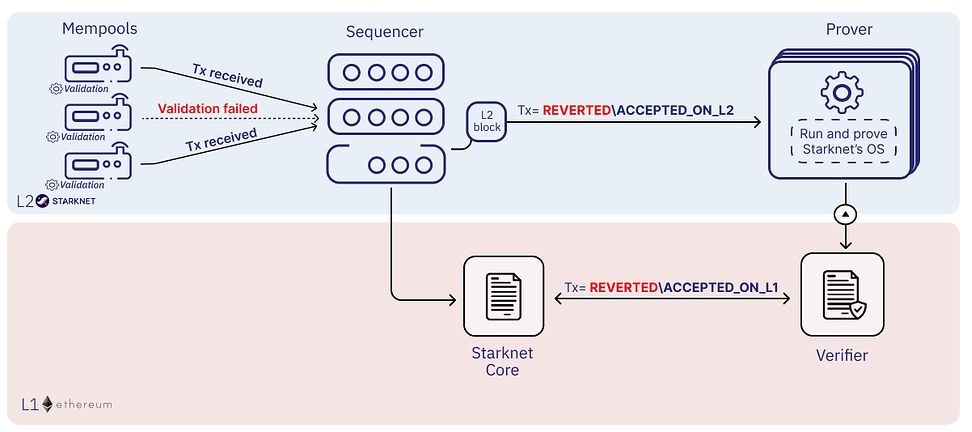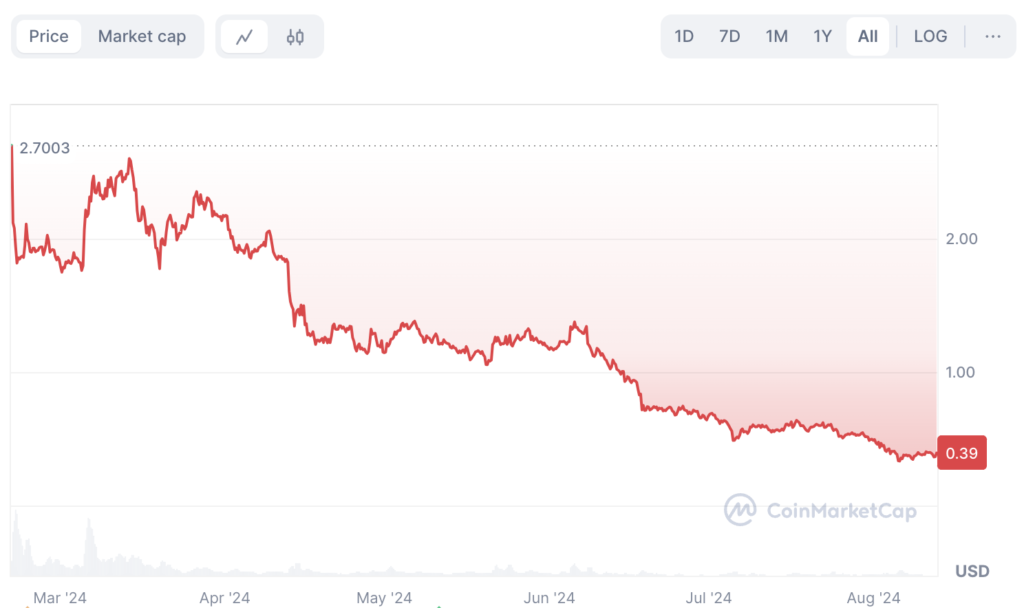Starknet: A Secure Scaling Solution
By Selene Wang | Crescent City Capital Market Analyst Intern
1. Introduction to Starknet
Starknet is a Validity-Rollup (aka ZK-Rollup) Layer 2 network that operates on top of Ethereum, enabling dApps to massively scale without compromising on security.
It achieves this by bundling transactions into an off-chain computed STARK proof. This proof is then submitted to Ethereum as a single transaction, resulting in significantly higher throughput, faster processing times, and much lower costs, all while retaining the robust security of the Ethereum settlement layer.
2. How does it work: Sequencers and Provers

Transactions are submitted to Starknet just as they would be on the mainnet. These are first processed and validated by sequencers, which act like Ethereum nodes with more capabilities. These computers put transactions into a queue called a mempool, and they propose blocks and then place these transactions into those blocks. Unsuccessful transactions don’t move forward. Once a group of transactions are executed and finalized into a block, the sequencer communicates to other sequencers for approval, and then the block is sent to provers.
Provers are responsible for further guaranteeing transactions in a block are valid. They organize blocks in groups (like sequencers process transactions) and process them in parallel, which makes the process faster. In doing so, they create an Execution Trace and a State Diff, which record the steps of transaction execution and how the state of Starknet changes, respectively. The Execution Trace then is fed through an algorithm that mixes together its data and identifies any bad data (such as a single bad transaction). A small, random sample of transactions is then used as a verification for the STARK proof that contains thousands.
3. Tokenomics: The STRK Token
The STRK token serves multiple functions within the StarkNet ecosystem, including payment of fees and governance. Users of StarkNet are required to pay fees in STRK to submit and process transactions on the network. These transaction fees are crucial for providing the economic incentives that sustain and drive the network’s usage. Additionally, STRK plays a key role in the governance of the protocol. By “wrapping” STRK tokens into vSTRK (voting STRK) at a 1:1 ratio, users gain the ability to participate in community governance. This process allows them to either vote directly on proposals or delegate their voting power to another user. Once governance activities are completed, vSTRK can be “unwrapped” back into STRK, making the tokens available for other purposes within the ecosystem.
At inception, there were ten billion STRK tokens created by StarkWare. Although this was the total supply at launch, it is not considered the maximum supply. The development team planned for future releases of tokens through the protocol through staking and block rewards.
The original ten billion tokens were subject to a lock-up period so parties like the team and investors could not dump their tokens onto the market. However, StarkWare faced early backlash about a particularly short lock-up period of those tokens: 13% of tokens would be unlocked within approximately 2 months of public launch. Because of this, the lock-up schedule was quickly revised.
4. Market Analysis

Price & Market Cap Performance:
- Live price: $0.39
- All-Time High: $4.41 (Feb 20, 2024)
- All-Time Low: $0.3212 (Aug 05, 2024)
- Live market cap: $638,208,642
- Circulating supply: 1,619,969,137 STRK coins
Past performance:
The StarkNet Foundation announced the airdrop of STRK tokens to over 13 million eligible wallets in Feb 2024. It’s the largest initial distribution by eligible addresses so far. After the initial surge, as early adopters began taking profits, STRK’s price declined drastically, resulted in disappointment from many users.
In May 2024, Starknet Foundation Launches $5 Million Grant Program aimed at supporting new projects on Starknet. In June 2024, Starknet announced their expansion from Ethereum to Bitcoin. Starknet will become the first network to settle simultaneously on Bitcoin and Ethereum and scale Bitcoin to many thousands of transactions per second. These developments have supported price stabilization.
However, there has been a steep decline since its launch. The dissatisfaction regarding the criteria for airdrop distribution influenced the sentiment of active users. Besides, the recent shutdown of the decentralized exchange ZKX, built on Starknet, has drawn criticism for its poor communication and lack of transparency, particularly among major investors. On August 7th, Starknet CEO steps down because of the controversial airdrop.
Technical analysis:


Moving Averages (SMA) Analysis: The long-term SMA stands at $0.432, which is significantly above the 20-day and 50-day SMAs, indicating an overall bearish trend in the longer term. The 20-day SMA crossing slightly above the 50-day SMA could signal short-term stabilization or a minor bullish retracement. However, this movement is modest and may not indicate a strong reversal, especially given the downward sloping 200-day SMA.
Relative Strength Index (RSI) Analysis: The current RSI is 58.16, which falls within the neutral to slightly overbought range. The RSI previously dropped to a low of roundly 28 before bouncing back, which indicates that the market may have been oversold temporarily but is now recovering.
In summary, while there are signs of short-term stabilization and there may be some short-term opportunities, the overall trend remains bearish.
5. Summary
Starknet is a Layer 2 scaling solution on Ethereum that uses zk-Rollup technology to enhance transaction throughput and reduce costs while maintaining Ethereum’s security. It processes transactions off-chain through sequencers, which validate and queue transactions before finalizing them into blocks. These blocks are then further validated by provers, ensuring the integrity of the transactions through advanced cryptographic proofs.
The STRK token plays a dual role in the ecosystem, serving as both the payment for transaction fees and a governance token. Users can participate in protocol governance by converting STRK into vSTRK, which allows them to vote on proposals or delegate voting power. However, STRK’s price has been highly volatile. After its airdrop to over 13 million wallets in February 2024, the token faced significant declines due to profit-taking and user dissatisfaction with the airdrop distribution. Despite some stabilization efforts through new initiatives, the overall trend remains bearish.
There may be a short-term investment opportunity at the current price level. If investors enter the market now, the target exit could be around $0.48. However, if the price fails to rebound and drops to $0.32 or lower, it would be prudent to consider exiting the position to mitigate further losses.
Reference
https://coinmarketcap.com/currencies/starknet-token
https://www.bitstamp.net/learn/cryptocurrency-guide/what-is-starknet-strk
https://starkware.co/blog/scaling-bitcoin-for-mass-use/

